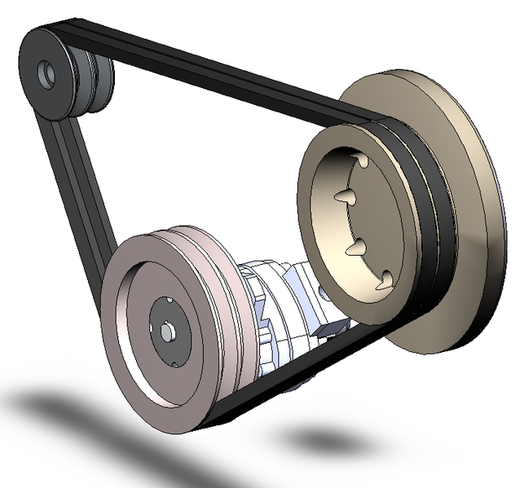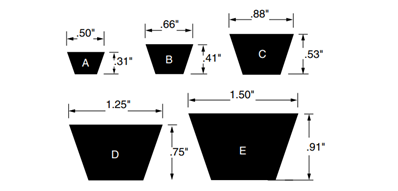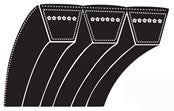
V-belts look like simple components in a machine that can be discarded when failing and replaced with a new one. In the end, they are nothing more than a simple rubber band, right? You only need the size of the circumference and the width of the band to get the replacement and put your machine back to work.
Well, the truth is that more often than not thinking like that leads to machine failure, downtime, and increased costs. In other words, your process will be less efficient and much less profitable.
This guide reveals the most important aspects of v-belts, their applications, and how to make a better choice when selecting the best v-belt for a specific application.
What are v-belts?
A v-belt is a flexible machine element used to convey power between a series of grooved pulleys or sheaves. As the name suggests, v-belts are V-shaped belts having a trapezium cross-section. V-belts are the most frequently used belt drives since their design enables them to wedge tightly into the groove when the system increases the tension.
As the belt wedges into the groove, friction between the surface of the belt is enhanced, enabling large torques to be delivered. The greater friction lowers the loss of power via slippage, a common problem found when using flat belts.
V-belts Profiles
The terms v-belts profiles refer to the characteristics of the cross-section, characteristics that are associated with manufacturing standards.
Common industrial profiles include US Standard (A, B, C, D, E) and Metric Series Metric V belts (SPA, SPB, SPC, SPZ, XPA, XPB, XPC, XPZ, 10X).
Standard V belts
Classical V-belts or conventional v-belts (classified by their dimensions from A to E), Wedged or Narrow V-belts (ranked by their dimensions 3V, 5V, and 8V), and Cogged V-belts (classified by their sizes AX, BX, CX, 3VX, 5VX, and 8VX) are three types of standard v belts in most of the industries.
Conventional V belts or classical V-belt (A B C D E)
The conventional V-belt, also known as the Classical V-belt, is the most frequent and oldest variety of V-belt. Traditional V-belts can handle loads ranging from a tenth of horsepower to 500 horsepower.
Conventional v belts or classical v-belts are quiet and lead to greater bearing loads in most cases. In addition, these v-belts are lightweight and economically friendly and can operate under very tough conditions.
The cross-section size and the inside length in inches are the measurements utilized for the part number employed for classical v-belts. For example, the letter A always refers to a top width of .5 inches (as shown in the image below). Therefore, the code A14 refers to a v-belt with a top width of .5 inches and 14 inches of inside circumference that is easily measured with a soft measuring tape, just like our Bestorq A14 Classical Wrapped Belts

Application:
This type of v-belts is widely used across different industries such as energy, agriculture, paper, and wood industries on machinery requiring up to 500 hp, and usually under rough operating conditions. This is because these industrial v-belts can usually withstand these conditions better than the rest, but bearings require attention and they must be robust enough, as these v-belts also generate higher bearing loads. Common machinery and equipment that use these industrial v-belts include but are not limited to:
- HVAC (heating, ventilation, and air conditioning) units
- Compressors
- Bulk material conveyors
- Metalworking machinery
Biemko Conventional or Classical V belts: Bestorq A14 Classical Wrapped Belts, GATES HI-POWER II BELTS A100, BANDO A128 POWER KING CLASSICAL, BANDO B110 POWER KING CLASSICAL, GATES HI-POWER II BELTS B105, BANDO C99 POWER KING CLASSICAL, BANDO D540 POWER KING CLASSICAL, BANDO E330 POWER KING CLASSICAL
Wedged or narrow (3V 5V 8V)
Due to an increased depth to breadth ratio, narrow or wedged belts are ideal for load transmission and force distribution, which is the main advantage over the conventional type.
Narrow belts are also suitable for drives with high belt speeds due to the compact design. Narrow v-belts may transfer up to three times the horsepower of a traditional V-belt. They are capable of handling motors ranging from 1 to 1000 horsepower.
To select the right v belt sizes using a narrow v-belt for a specific application, attention must be given to the part number of the belt. For example, a belt with the width of the cross-section measured around .38 inches (3/8") would correspond to a narrow v-belt with a 3V profile as illustrated in the image below.
Also, if the length of the outside circumference, which can be measured with a soft tape is around 59 inches, then the v-belt corresponds to a narrow v-belt with part number 3V590, just like the GATES SUPER HC BELTS 3V590 we sell.

Application:
The narrow type of v-belts is used for applications requiring a level of speed and horsepower where conventional v-belts are not suitable. Also, having a better load distribution, narrow v-belts are a great choice for applications where a reduction of the loads on the bearings is desired. In addition, the narrow section of these v-belts is more suitable for applications requiring space savings and less weight applied.
Common machinery using narrow v-belts include but are not limited to:
- Small electric tools
- Mud Pumps
- Fans
- Tractors and other agricultural machines
- Snow Plows
Biemko Wedged V-belts or Narrow V-belts: GATES SUPER HC BELTS 3V590, BANDO 3V750 POWER ACE NARROW, BESTORQ 19/3V530 BANDED WEDGE BELTS, GATES PREDATOR SINGLE BELTS 5VP950, BESTORQ 16/5V2500 BANDED WEDGE BELTS, BANDO 5V950 POWER ACE NARROW, GATES PREDATOR SINGLE BELTS 8VP3550, BANDO 6-8V6000 POWER ACE COMBO NARROW, BESTORQ 3/8V2240 BANDED WEDGE BELTS.
Cogged V-belt (AX BX CX 3VX 5VX 8VX)
Cogged V-belts feature grooves or notches running perpendicular to the length of the belt on the inner surface which enable the belt to bend and flex more freely, dissipating heat and operating cooler than non-cogged V-belts. This is highly beneficial since heat is a major contributor to the premature failure of the belt. Cogged belts may be used on the same pulleys as conventional v-belts since they are dimensionally similar without the slots.
The part number for the cogged v-belts is the same as with conventional and narrow v-belts but adding the letter X to identify the distinctive feature. A conventional cogged v-belt with a top width of .50 inches and 95 inches of length, corresponds to a v-belt with part number AX95 like the GATES TRI-POWER BELTS AX95.

Credit Source: www.gates.com
Application:
These v-belts are perfect for tiny drives and high speeds, twisting or turning drives, or sprocket pulleys that you need to keep from slipping.
Cogged v-belts are more efficient and better suited for applications where high vibration requires some damping or when there are shock loads that may cause torque to change abruptly, thus causing shear on a synchronous belt’s teeth.
Synchronous or timing belts are more suitable for wet and oily operating conditions where they can work without slipping.
Common machines where these v-belts are used include but are not limited to:
- Vehicles equipped with internal combustion engines
- Roof top air conditioners
- Centrifugal pumps
- Clutching systems
Biemko Cogged V-belts: GATES TRI-POWER BELTS AX95, BANDO AX173 POWER KING RAW EDGE COG CLASSICAL, BESTORQ 3/BX48 BANDED COGGED WRAPPED BELTS, BANDO CX128 POWER KING RAW EDGE COG CLASSICAL, GATES SUPER HC MOLDED NOTCH BELTS 3VX1500, BANDO 6-5VX950 POWER ACE COG COMBO NARROW
Metric V belts (SPA, SPB, SPC, XPZ, SPZ, XPA, XPB, XPZ, 10x,13x, 17x)
These are v-belts which are the same as the previous types, with the main difference being that they have their main specifications in metric units and follow international standards set by organizations such as ISO (International Organization for Standardization) and DIN (the German Institute for Standardization).
When a machine is made by an international manufacturer (outside the US) metric v-belts become a better choice as they are manufactured to metric tolerances for a precise fit in metric pulleys, thus providing more torque and flexibility.
These v-belts are often utilized as replacement belts on industrial equipment, such as textile mills, machine tools, and food processing facilities.
Metric V-belts may provide up to 100% more horsepower than traditional sectioned belts with the same top width. The manufacturers use dimensional adjustments, improved cable manufacturing, and optimal cord line placement to accomplish this.
As you can expect, they also come in conventional and narrow types with the same differences between the two types.
Metric V-belt cross-sections are specified as SPZ, SPA, SPB, and SPC (DIN and ISO narrow), Y, Z, A, B, C, D, and E (ISO classical), and 10X, 13X, and 17X (DIN classical). The nominal dimensions for ISO and DIN type belts are metric-based (millimeters).
Classical V-belt sizes in the metric (DIN-based) system are identified by a number followed by an "X" (10X, 13X, and 17X) followed by the length in millimeters (for example, 10X530). Narrow metric ISO and DIN type belts are identified with cross-section letters (SPZ, SPA, SPB, SPC) followed by the length in millimeters (for example, SPZ1500). An "X" in place of the "S" in these part numbers (for example, XPZ1500) generally designates that the belt is cogged. However, not all manufacturers follow this convention. When ordering a replacement, it is best to specify whether or not the belt is cogged.

Application:
The same applications described above apply for conventional metric v-belts and narrow metric v-belts. However, it is very important to ensure if your specific application requires a metric v-belt to avoid the drawbacks of replacing US standard v-belts with metric ones.
For example, there can be problems with the speed ratio of the drive and the power capacity when using a belt with a different angle of the cross-section, even if other measurements are equivalent. Also, belts may not sit properly on the sheaves and this could result in accelerated sheave wear and early failure of the v-belt.
Biemko Metric V belts: GATES METRIC-POWER V-BELTS SPA4500, BANDO SPA982 METRIC V, BANDO SPB2050 METRIC V, GATES METRIC-POWER V-BELTS SPC9000, BANDO XPZ1162 METRIC V, GATES METRIC-POWER V-BELTS XPA982, BANDO SPZ2287 METRIC V
Other V-belt types used in industry and manufacturing
Light Duty Profiles or Fractional Horse Power V belts (3L 4L 5L)
Fractional Horsepower (FHB) V-Belts are suitable for optimal tension control, drive uniformity, and extended life with little heat build-up and straining on low horsepower electric motors and gasoline engines.
The thinner cross-section and lighter gauge tensile cord makes these v-belts more flexible and provide them the possibility to bend around small sheaves, making them a great choice for applications with very limited space where the smallest pulleys are used.
FHP belts have a part number that is similar to wedge v-belts. The profiles are identified with 2L, 3L, 4L, or 5L respectively. The number prefix indicates the belt top width in one-eighth of an inch, followed by the nominal outer length in inches. Part number 3L300, for example, denotes a 0.38" top width and a 30.0" outer circumference.

Application:
FHP light-duty V-belts are often utilized as a single belt on one horsepower or less drive. It's suitable for withstanding relatively light loads. Common machines where these v-belts are applied include but are not limited to:
- Domestic washing machines
- Tiny fans
- Refrigerators
- Garage equipment
- Lawnmowers
- Snowblowers
- Furnace fans
Biemko FHP Low Duty Profiles: GATES POWERATED V-BELTS 3L740K, 6774, BANDO 3L270 DURAFLEX GL FRACTIONAL HORSEPOWER, BANDO 4L240 DURAFLEX GL FRACTIONAL HORSEPOWER, GATES POWERATED V-BELTS 5L990K, 6999
Hexagonal Profiles (AA BB CC Double V)
Hexagonal Belts, also called double-sided v-belts, feature a special construction where two traditional v-belts are put together back to back or one top in contact with the other.
The main use for this type of v-belts is in double-sided drives. Having a special design, hexagonal belts can operate on several pulleys with varying rotational directions. Common drives using this type of belt are the serpentine drives, where the power is to be transmitted from both sides of the belt.
Among the most relevant mechanical properties we can mention that they provide great torque, they are very strong and highly durable.
The part number is the same as the part number of conventional v-belts with a double letter to denote the double-sided type. For example, the GATES HI-POWER II DUBL-V BELTS AA90 is a double-sided v-belt with a top width of .51 inches and an outside circumference of 93.48 inches (about 90).

Application:
These v belts are the best choice for applications where sudden directional changes in the belt travel occur. These changes exert unique stress on the structure of the belt, but double v-belts are perfectly designed to resist and remain aligned both laterally and longitudinally, in the pulley groove, while operating.
Common machinery where hexagonal or double-sided v-belts are used include but are not limited to:
- Rice mills
- Husker machines
- Poultry feather pickers
- Electric cars
- Packaging machinery
Biemko Hexagonal V-belt: GATES HI-POWER II DUBL-V BELTS AA90, BANDO CC173 DOUBLE-V, BANDO AA148 DOUBLE-V
Banded v-belts Profiles
Banded v-belts or joint v-belts is the combination of multiple v-belts that are put together through a continuous band that ties them across their backs or tops. These v-belts are wedged into matched pulleys to reduce vibrations or pulsate loads, especially in applications where the distance between the two centers is too long.
The part number used is simple. The first number indicates the number of bands or v-belts in the component, then it uses the measures of the cross-section of one of the v-belts in the band and then the approximation of the outside circumferences in 1/10 of an inch. For example, the BESTORQ 18/8VK5000 BANDED KEVLAR BELTS is a banded aramid v-belt with 18 bands, top width of 1 inch (taken from 8V profile) for each band (18 inches total), and an outside circumference of 500.0 inches.

Credit Source: www.Bestorq.com
Application:
Due to the characteristics described above, banded v-belts are commonly applied vertical shaft drives, clutching drives, and V-flat drives.
Commonly manufactured with high-resistance materials such as Kevlar (Aramid), these banded belts are the more suitable for the toughest of the environments. Therefore, banded belts are used in a wide variety of industries such as agriculture, pulp & paper, forestry, mining, construction, lumber, manufacturing, and oil & gas.
Common machines where you can see banded v-belts applied include but are not limited to:
- Internal combustion engines
- Reciprocating pumps.
- Reciprocating compressors.
- High precision machine tools
- Crushers for the mining industry
- Excavators
- Conveyors
Biemko Banded Belts: Bando 2-3V1060 Power Ace Combo Narrow, BESTORQ 24/3VK1180 BANDED KEVLAR BELTS, Bando 2-3VX1120 Power Ace Cog Combo Narrow, BESTORQ 18/8VK5000 BANDED KEVLAR BELTS
Final words on v-belts
There are many v-belt types and v-belt sizes to cover a wide variety of applications. To purchase the most adequate v-belt, the part number is key. When the part number is blurred or has just disappeared due to wear, measuring the cross-section dimensions and the circumference can be useful to identify the belt and provide the corresponding part number to the supplier.
At Biemko we distribute a wide variety of power transmissions v-belts and belt drives to keep your machinery and equipment working smoothly and effectively. We sell light duty to heavy load equipment v belts for various commercial and industrial sectors.
If you already know what belt you need, you can explore our comprehensive range of Gates, Bando, Bestorq V-belts, and all other specialty belts. Of course, if you need assistance in finding a V belt or have any other inquires, do not hesitate to Contact Us or chat with us online.

